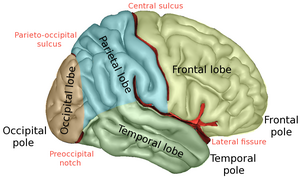Brain lobe
| Cerebral lobes | |
|---|---|

Lateral surface of cerebrum. 4 lobes are shown.
|
|

Medial surface of cerebrum. 5 lobes are shown.
|
|
| Identifiers | |
| NeuroNames | hier-1210 |
| NeuroLex ID | Lobe of cerebral cortex |
| TA | A14.1.09.005 |
| FMA | 61823 77800, 61823 |
|
Anatomical terms of neuroanatomy
[]
|
|
The lobes of the brain were originally a purely anatomical classification, but have been shown also to be related to different brain functions. The cerebrum, the largest portion of the human brain, is divided into lobes, but so is the cerebellum. If not specified, the expression "lobes of the brain" refers to the cerebrum.
Terminologia Anatomica (1998) divides cerebrum into 6 lobes.
The frontal lobe is located at the front of each cerebral hemisphere and positioned in front of the parietal lobe and above and in front of the temporal lobe. It is separated from parietal lobe by a space between tissues called the central sulcus, and from the temporal lobe by a deep fold called the lateral sulcus also called the Sylvian fissure. The precentral gyrus, forming the posterior border of the frontal lobe, contains the primary motor cortex, which controls voluntary movements of specific body parts.
The frontal lobe contains most of the dopamine-delicate neurons in the cerebral cortex. The dopamine system is associated with reward, attention, short-term memory tasks, planning, and motivation. Dopamine tends to limit and select sensory information arriving from the thalamus to the forebrain. A report from the National Institute of Mental Health says a gene variant that reduces dopamine activity in the prefrontal cortex is related to poorer performance and inefficient functioning of that brain region during working memory tasks, and to a slightly increased risk for schizophrenia.
...
Wikipedia
